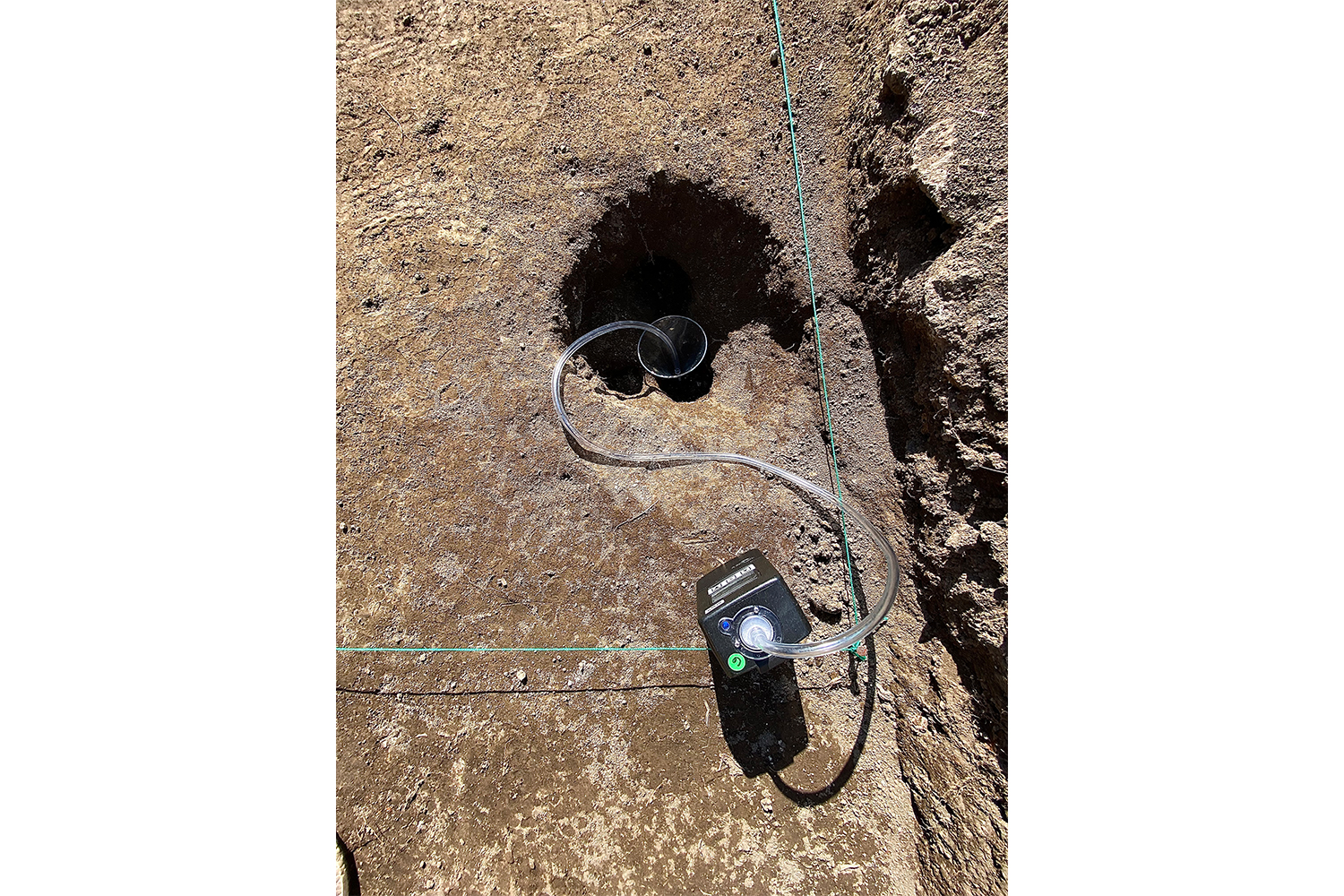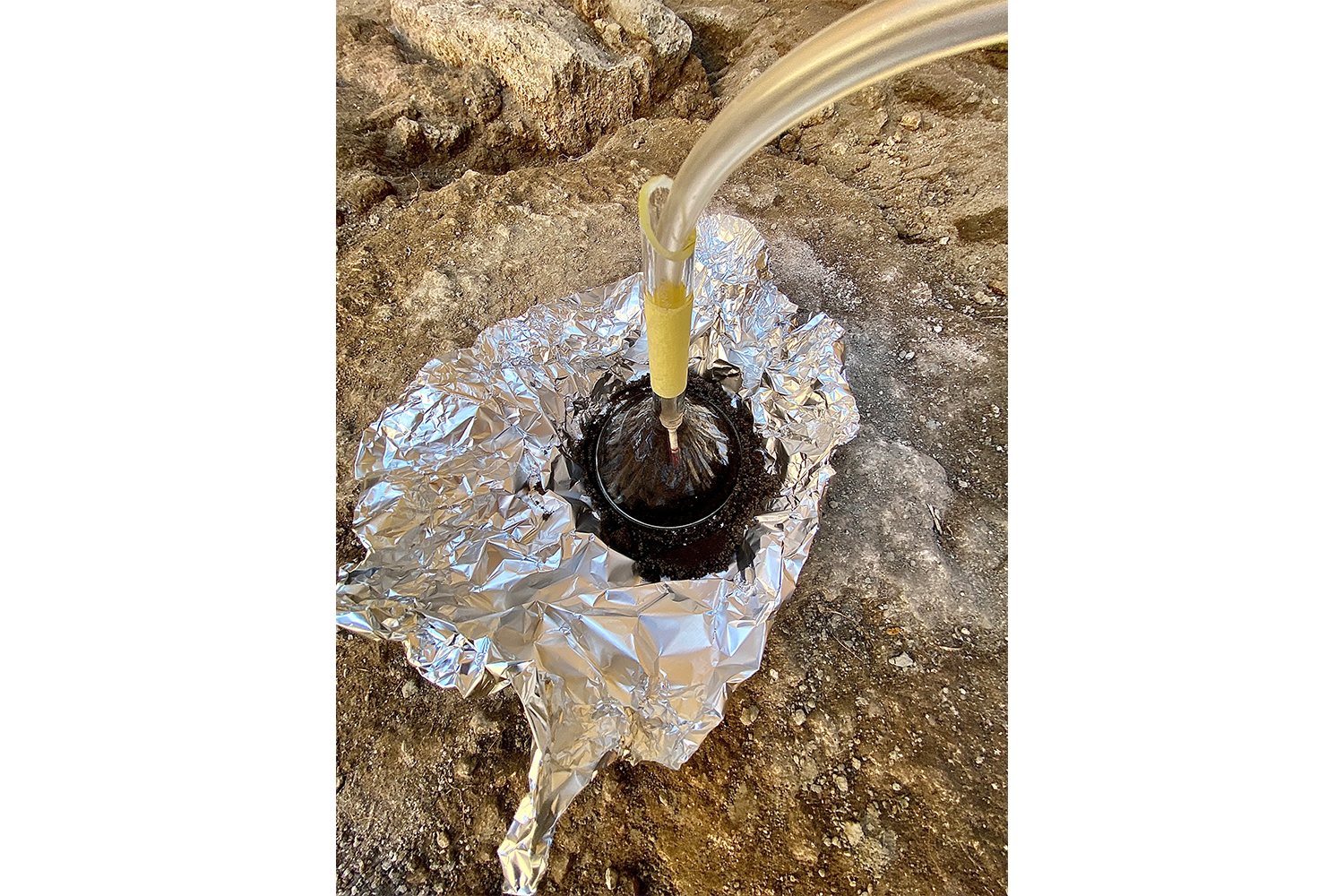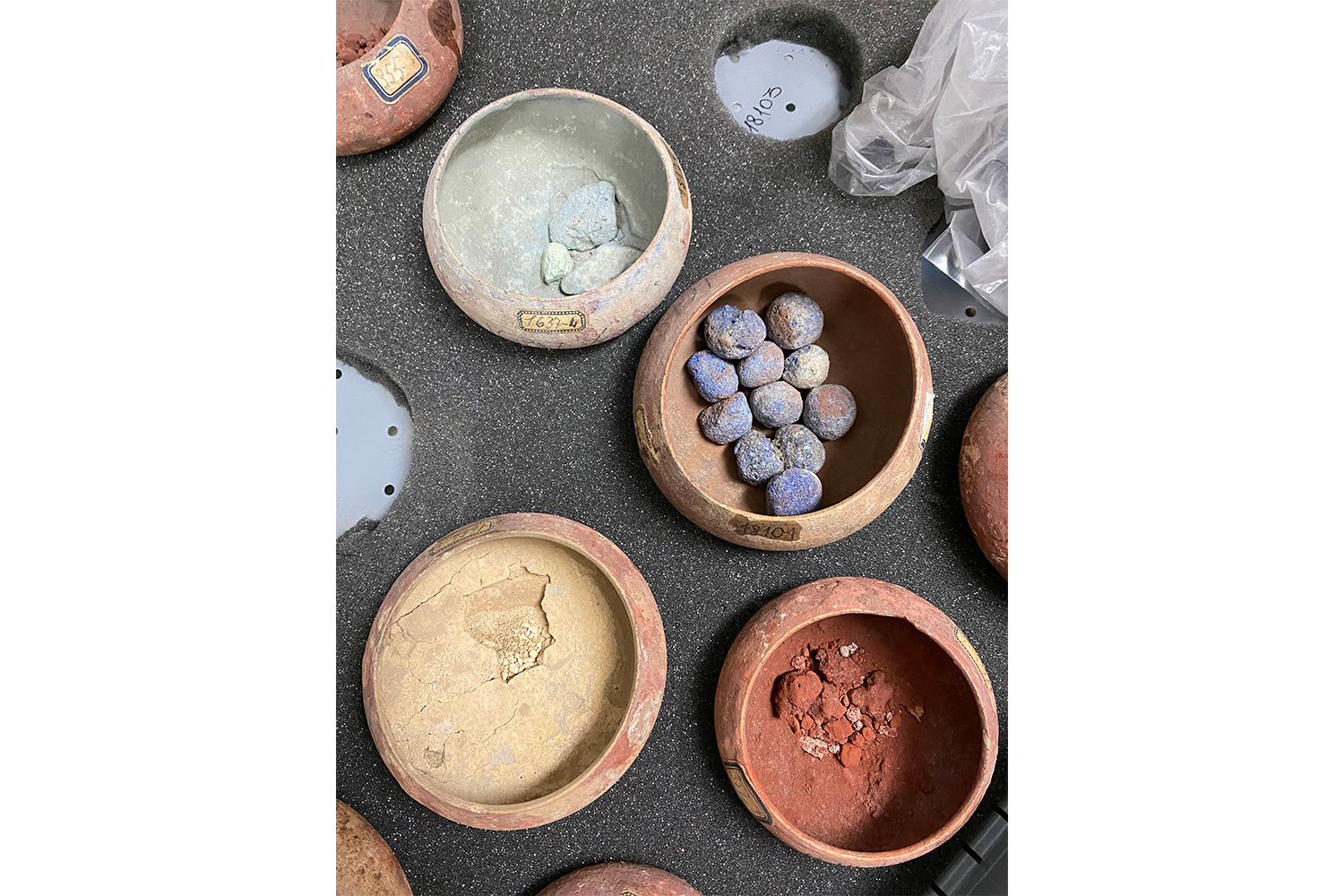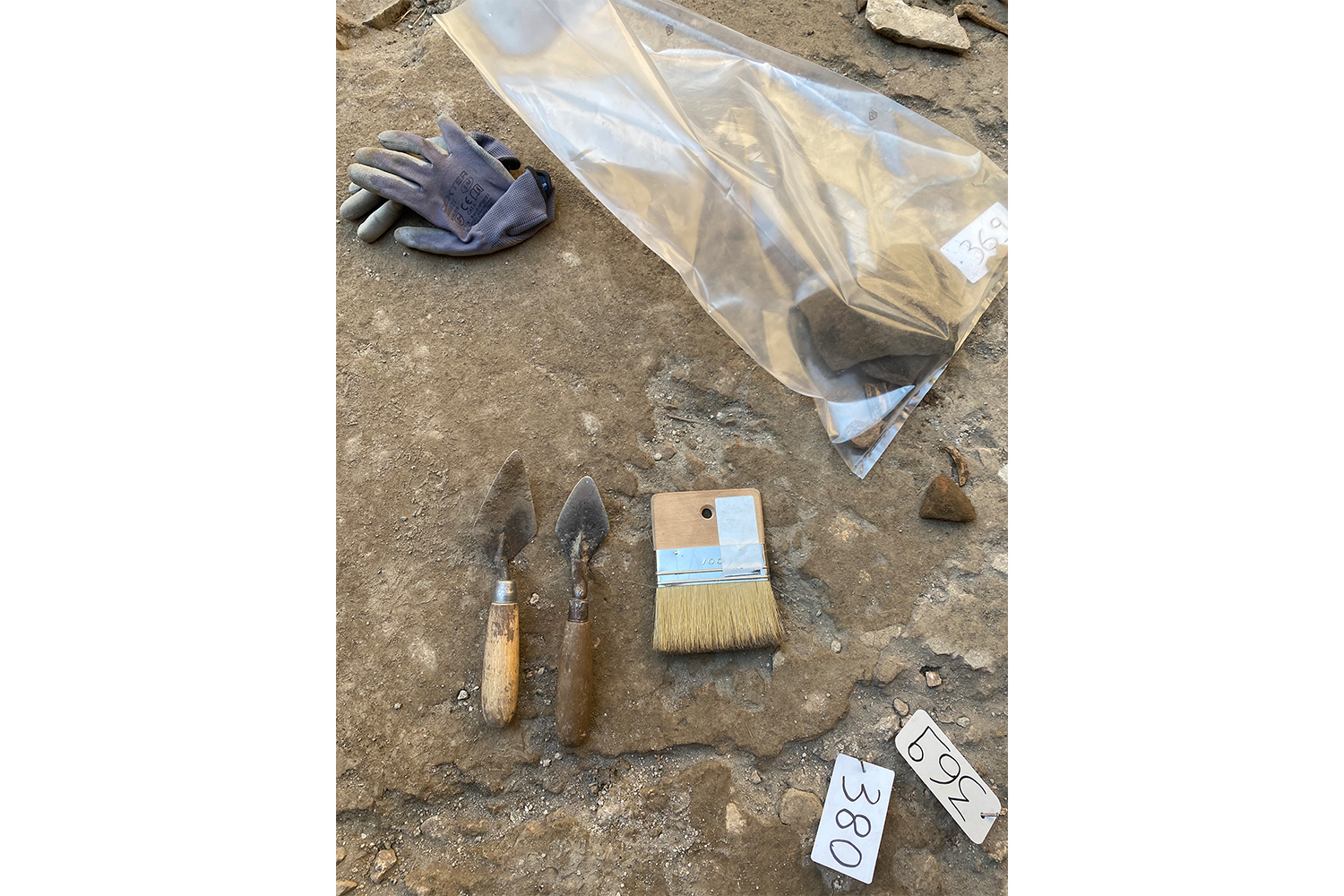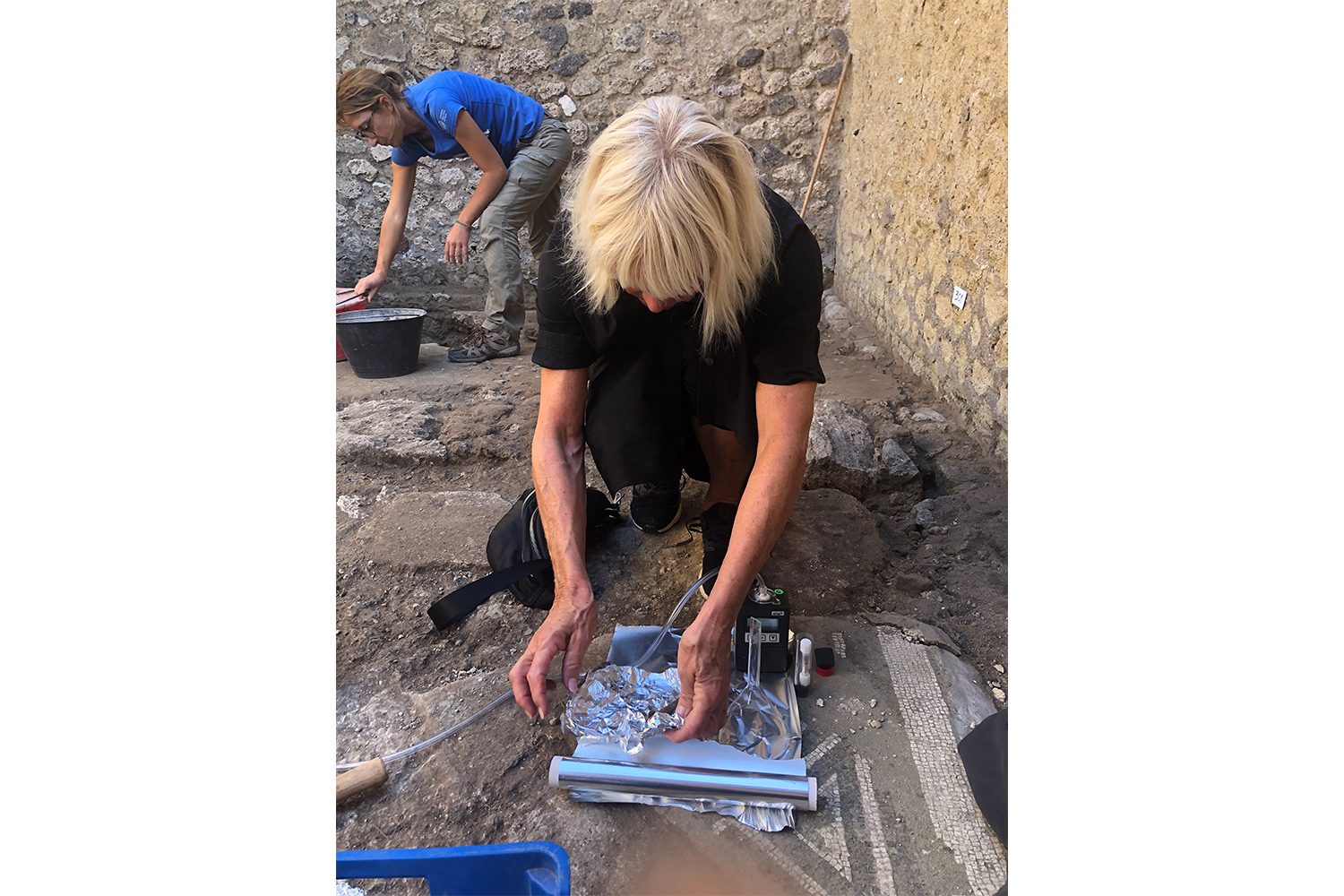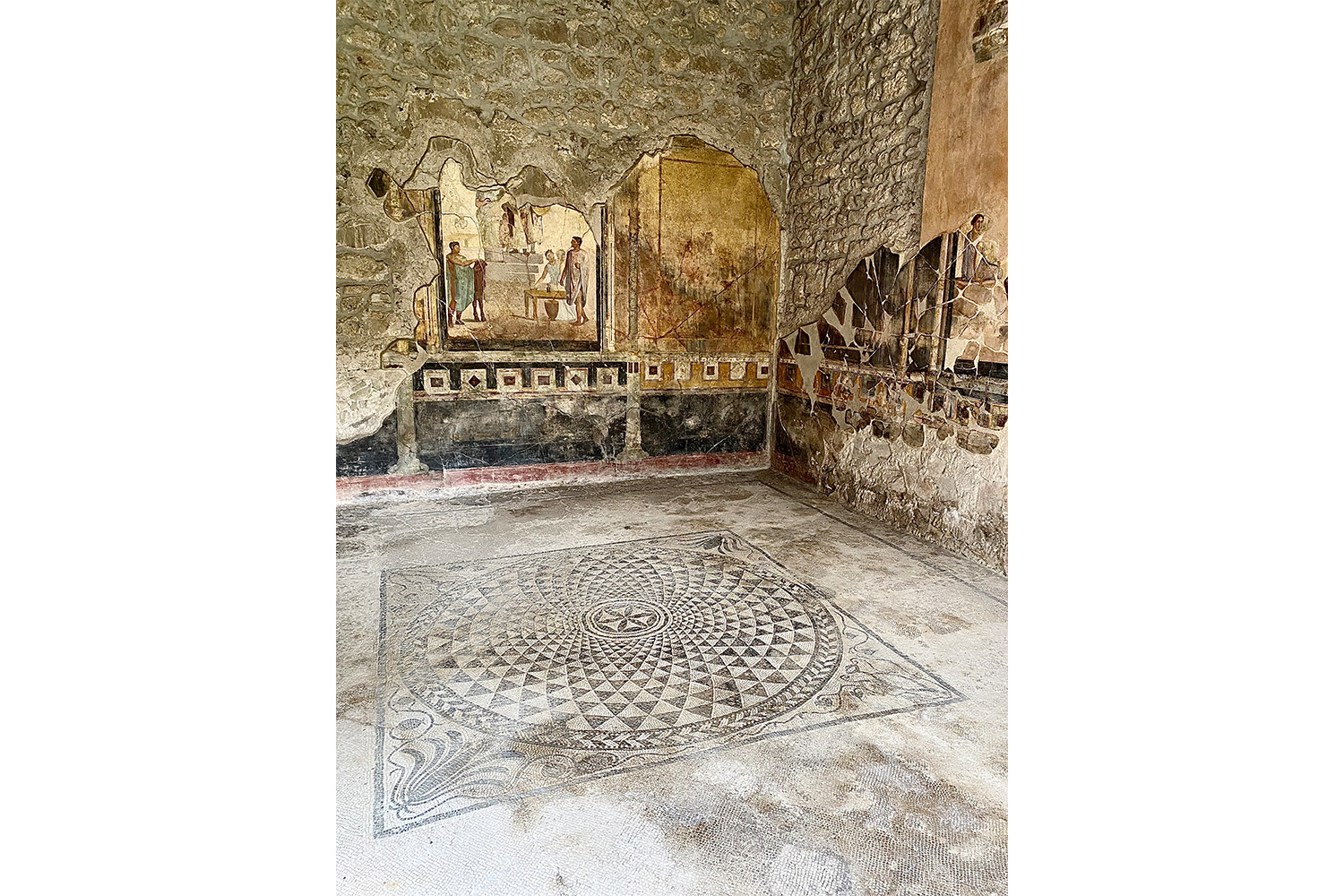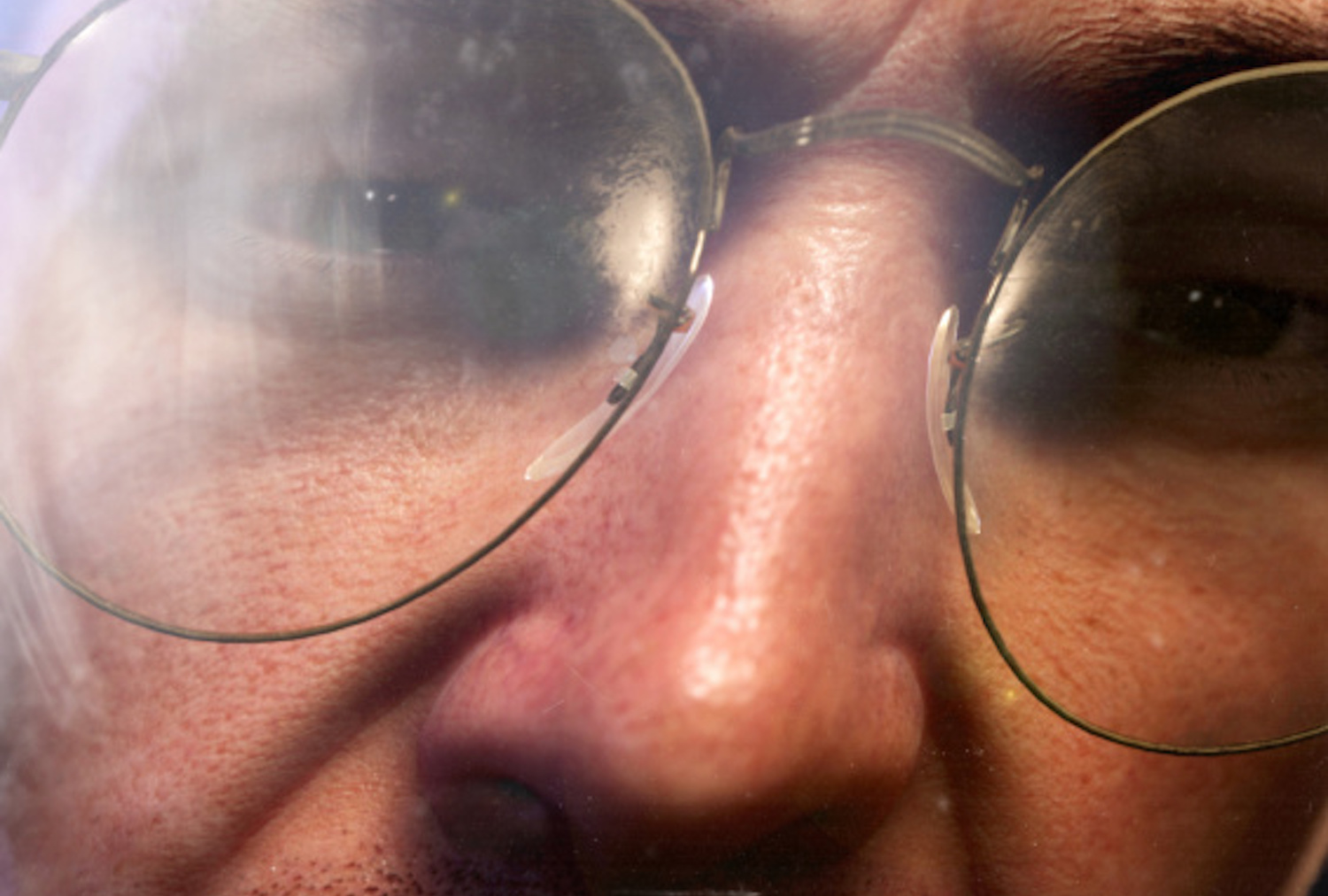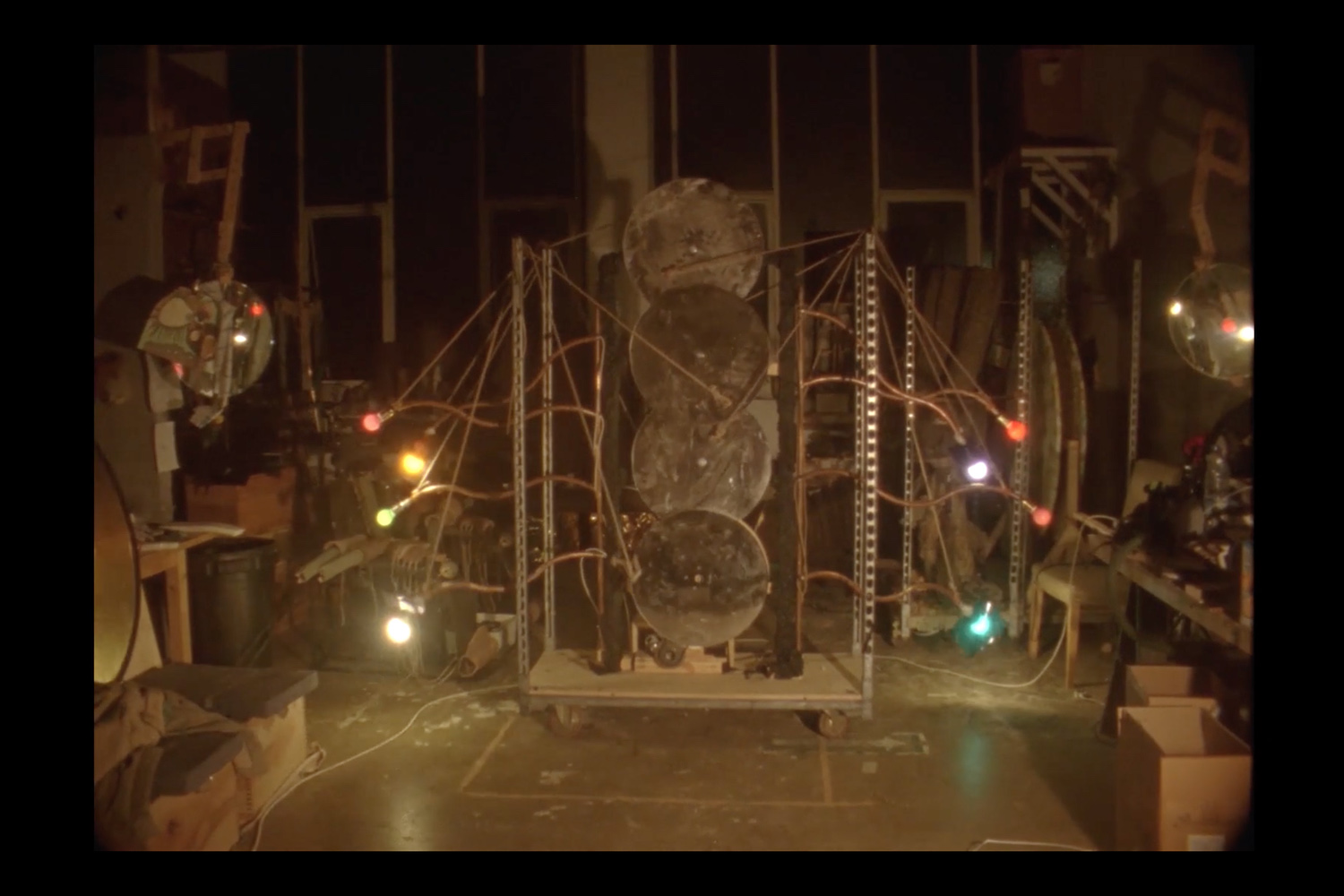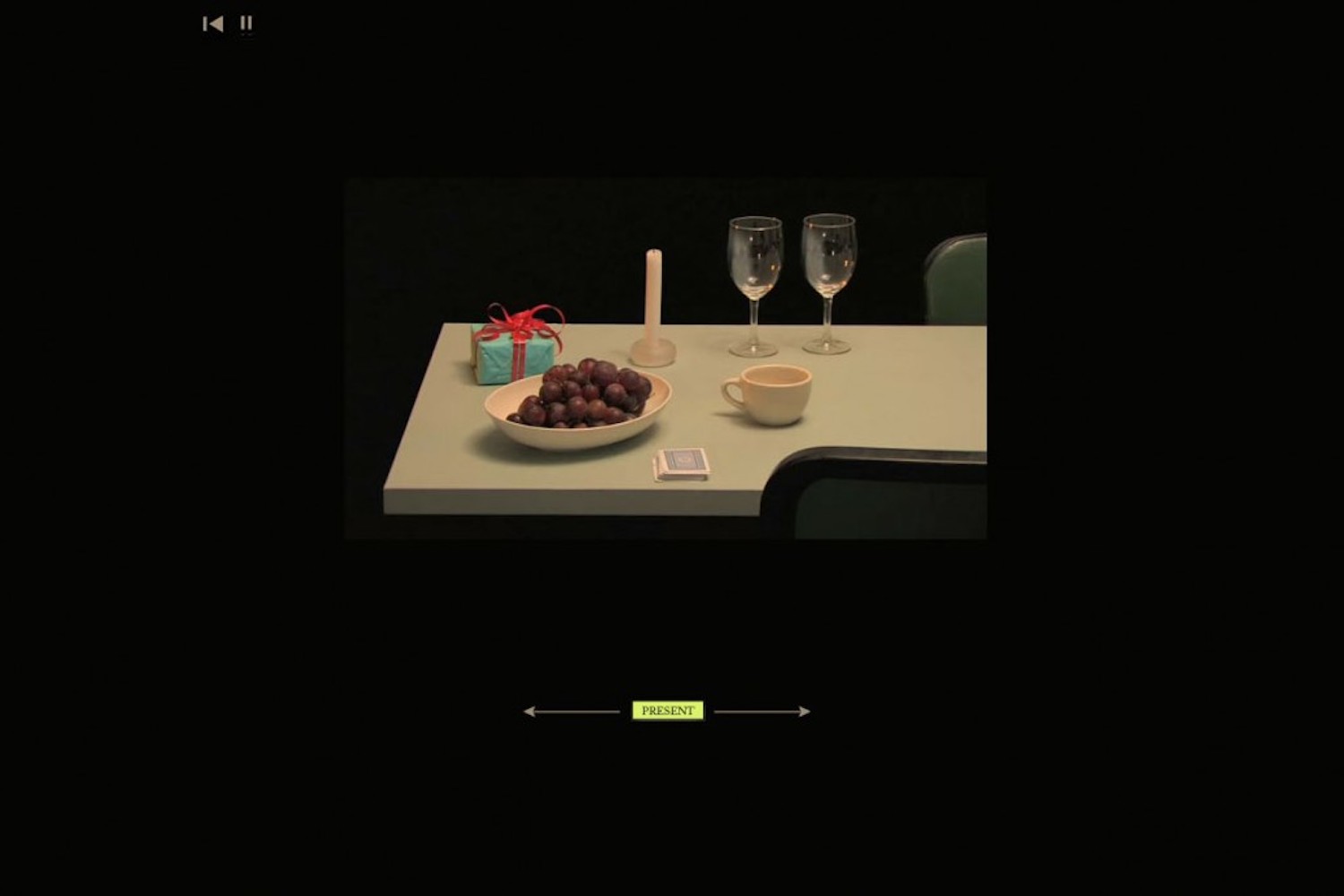
Andrea Viliani: Process, in your artistic practice, both adopts and defines a protocol, a methodology, that has the same relevance as the final result. Can you describe how you applied your process to the research that you conducted at the Archeological Park of Pompeii, in the context of Pompeii Commitment: Archaeological Matters and in collaboration with our partner, the Nicoletta Fiorucci Foundation?
Sissel Tolaas: Wherever there is air, there is life, there are smell molecules. In the context of an archeological site, smell molecules are everywhere, literally embedded on both micro and macro levels. For me, the process — that is only apparently intricate and abstract — begins with my presence at the site, equipped with my most advanced interface, the nose. It is through the remarkable capabilities of the nose that we can discern and identify a staggering number of molecules, up to a trillion. In addition to the human nose, multiple instruments and advanced technologies can aid us in recording core molecules within a given environment. However, the human nose remains crucial in determining what and where to focus the molecule recordings, as well as later making sense of the data.
Having dedicated twenty-five years to this endeavor, I believe I can confidently claim that my olfactory sense has developed into a highly sophisticated tool. At times, I even find myself contemplating that the human nose is more sophisticated and advanced than any technological device I could ever employ in the process of recording volatile molecules emitted from a source of smell.
The process entails being in the field independently, yet also engaging in dialogue with archaeologists, anthropologists, biologists, geologists, psychologists, and any other individuals who are present at the location. The preliminary conversation prior to any excavation is equally important. It ensures that everyone involved comprehends the objectives I seek to achieve. My expertise in organic chemistry, neuroscience, biology, and other relevant fields, along with the shared enthusiasm and compassion regarding the topic of concern, are all essential elements for achieving a successful result.
In general, I have been employing my nose to gain a new understanding of the world more so than relying on my eyes. It is fascinating to explore how the senses can operate both individually and in harmony. In the context of Pompeii it is all about cooperation, coherence, and collaboration, while relying on the expertise of archaeologists, their methodologies of work, and their established protocols.
AV: So, we can say that Sissel Tolaas’s practice — which implies collecting and analyzing data, and building archives — is both process-based and archive-based but, mostly, it’s a nose-based and nevertheless collective process. How did archaeologists react to this process?
ST: In the field of archaeology, and similarly in the realm of understanding smell, we have encountered a certain point where progress seems to have stagnated or become stuck.
I embarked on my exploration of the sense of smell at a particular moment in history when its understanding and appreciation were confined within a metaphorical hermetic box. I found myself immersed in a knowledge framework that provided a sense of comfort for those who aimed to conceal aspects of the world they were unaware of. Even back then, my approach was driven by the question: “Can I contribute to uncovering the world before it becomes masked by additional smells that are unrelated to what they conceal?”
This kind of anecdote still holds true for my process and how I utilize the knowledge of smell in the world where we all coexist and actively contribute. SMELL is AIR is indeed a collective endeavor, and my goal is to assist everyone in recognizing and perhaps even fostering a deeper appreciation for this shared reality. Whether we can embark on comprehending other forms of information and communication, such as chemical communication, hinges on curiosity and the willingness to venture beyond one’s comfort zone.
In the process of excavation, the search primarily revolves around tangible remains like bones, stones, ceramics, and glass. However, what would happen if one also cultivated an awareness of the olfactory experience while uncovering the layers of soil and dust?
The moment one exposes the different layers, the air itself is released and changed. Yes, that very air — you breathe it, and I have recorded it. Being mindful of the significant role played by all the senses and their ability to add joy and playfulness to the moment of understanding, even in the field of archaeology, you suddenly find that the entire archaeological site transforms into a sensory playground.
In science, one should not let their own emotions cloud their judgment. And then, when we write the protocol, we can adopt a hardcore, rational, and pragmatic approach, as required in our scientific endeavors. However, this is where I, as an artist and scientist, come into play. I proclaim, “Yes, I also employ hardcore scientific protocols,” but I also possess the freedom to state, “I will emphasize specific parts of the data for particular purposes that I think are relevant to the story.”
My process is, indeed, an homage to memory, utilizing smell as a catalyst to activate it and raising questions about the nature of the past, the present, and the future of memory. In terms of what we aim to remember, the differentiation between collective memory and individual memory becomes pertinent. It is here that the olfactory sense exhibits remarkable intelligence and capability, bypassing the rational aspects of the brain and effectively stimulating both memory and emotions. This is the headline of my protocol: “Exploring the Link between Reaction and Action: Insights into Chemistry, Memory Measurement, and Subconscious Data Recall.” It’s a multilayered approach to the issue or topic of concern, yet, nevertheless, the scientific aspect remains integral.
AV: Using smell as a research tool, you demonstrate that our nose is not just a physical part of our body but also an instrument for intellectual understanding. Your process needs to start with chemical data, but it drafts the further possibility of telling stories connected to these data. In an archeological context, artists could be perceived as an alien disciplinary interference, but at the same time they reveal something that the archeologists already know: they are scientists, but they also need to use their imaginations to “fill the gaps,” to face what they do not know or understand yet.
ST: That’s exactly what happened in Pompeii. “Oh, what’s she doing here? Who is she? What’s her purpose for being here?” Upon introducing myself, instead of being perceived as an outsider aiming to invade or disrupt, I swiftly became an integral part of a collective endeavor. It was as if we shared a mutual curiosity and the ability to adapt to new approaches. The conversations I’ve engaged in during fieldwork are just as significant as the data I’ve recorded from the diverse excavations. Moreover, these conversations have become an integral part of the archives I am building up. Like the conversations I had with a geologist who possessed expertise in deciphering the different strata. He invited me, saying, “You must come because I am uncovering the strata from 79 AD,” and I wondered, “How is it possible to interpret the various strata when you’re going so deep?” Being in the field was an awe-inspiring experience. It transformed our endeavor from mere digging into something profoundly holistic.
I was present alongside them, recording on the spot with my own instrument, and we began to realize that perhaps we could also perceive additional information through smell as we excavated further. How would we make sense of that information? How would that potentially influence how we can write a shared protocol? For generations, we have conducted archaeological research with a solid and established approach. I am not here to change it entirely. Rather, my objective is to challenge the status quo, encouraging a shift in perspective regarding what was once considered inflexible. In a constructive way: letting the people in the field — not just the archeologists and related experts, but the guides and the visitors, because the site was open, and they could observe us — tell or even alter their stories while seeing what’s actually going on. My presence, I believe, brought forth a distinct potential to the site, one that was thought-provoking and evocative. An archaeologist in the field primarily focuses on discovering physical artifacts rather than digging to record smell molecules emitted from the soil. However, the fact that I was engaging in such recording activities opened a new perspective for understanding Pompeii, not merely as a static place, but as a site that encompasses sensory dimensions as well. Hopefully, the conversations I have had in and about Pompeii, which will be included in the archive, will endure. By creating this archive, the process itself becomes a significant outcome, and I anticipate its ongoing continuation. We will do things with these data and make them accessible, adding “life” back to the ruins.
I have corrected and adapted to the most pressing problems, but I operate at the same time as a human being, part of an animal species, with my own unique way of interpreting and communicating my findings and observations. Nothing is more real than smell. What happens if you suddenly have the real authentic smells placed back in the ruins? What kind of story will we tell then?
We inhabit a world that is predominantly shaped by headlines and imagery, encompassing the realms of semiotics, semantics, and visuals. We often discuss the concept of interconnectivity and recognize that we are part of a larger interspecies framework. However, the question arises: How do we actually achieve this interconnectivity? How do we comprehend and make sense of different types of information?
That is precisely why I expressed my intention to explore and embrace a different form of information and communication and attempt to open up to this alternative approach.
To achieve this, it would necessitate the application of diverse scientific and artistic approaches within a firm context. Together, we may very well create new avenues and provide Pompeii with access to a context, content, and knowledge it may not have otherwise obtained. Wherever life exists or has existed, there are smell molecules present. Despite our navigation through multiple realities and the intertwining of various elements, the fundamental reality remains unchanged when we delve into its microscopic level.
With the advent of COVID-19, we have gained a newfound appreciation for the significance of our senses. We have come to understand the importance of interfaces and sensors, particularly in the context of sensory deprivation experienced during lockdowns and isolation. We can even go as far as labeling this endeavor a “smell heritage archive,” as the nature of smell is ephemeral. The moment we perceive a smell, it exists in that instant, and the next moment it vanishes, becoming extinct, blending with other molecules in the environment. It is never constant.
AV: You revealed how important it is, in such a solid place, to breathe. To collect data through breathing, which is something that, indeed, an archeologist doesn’t do often enough. When I discussed your methodology with archeologist Salvatore Settis, he told me that he dreamt of getting back to the smell of antique artifacts, but that he did not know how to do it. Which is exactly the research you were conducting in Pompeii: “What is the smell of a ruin?” Altering the perception of the site, your process — which itself is not an abstract position, being as scientific as it is narrative — revealed a potential set of data and a potential for storytelling that a site like Pompeii could activate while adopting and sharing a process like yours. Within which you didn’t just consider the Pompeiian artifacts, but eco-facts and bio-facts, which means bodies, both dead ones turned to dust and alive ones, the bodies of the workers, the visitors, the guides who interact together in the site. Being there to conduct your research, the site becomes an activator of all the senses, capturing micro moments like breathing, engaged with multiple collective memories revealed by smell. Archeological sites are immense sources of invisible and intangible information that is not yet included in their archives, and so within the archeological episteme. Which is quite paradoxical in this case, being that Pompeii is one of the few sites that, having been covered by the pyroclastic matter that erupted from Vesuvius in 79 AD, is much better preserved than other archeological sites in terms of its invisible and intangible data, like smell. Pompeii is an immense outdoor repository of very volatile (literally) data. In order to not lose this data, archeologists should start testing the ground differently and collecting this information. The knowledge is there; it is just not perceived. Even if the archeologists did not yet fully understand what you were doing there, Pompeii could become a landmark research center for “smell archeology.” Is it something you think could happen?
ST: I envision the establishment of a field laboratory, similar to those found in various other settings, where individuals can bring their mobile units. Smell is indeed tangible and real. It exists in the present moment and is deeply connected to its immediate surroundings. It is an in-situ experience that carries a significant sensory presence. Once soil is transported from one location to another, it becomes contaminated, compromising its original state. Similarly, if an object or sample is collected and placed in a plastic bag for transportation, it is already too late to maintain its pristine condition. Therefore, such actions are best avoided as they would not yield accurate results or worthwhile outcomes.
I envision a little smelling bubble in the field, set up to investigate smell molecules only, to acquire substantial immediate smell data in addition to major excavation activities. Excavations continue in various locations, with sites being opened and closed repeatedly. Why not explore alternative approaches or methodologies during these excavations? Pompeii, in its essence, can be seen as a preserved body, a living entity frozen in time by the ash. Within its layers, countless air bubbles encapsulate moments of the past. By carefully breaking and recording these bubbles, we have the opportunity to reveal and awaken the life that once thrived within them.
Additionally, we could collaborate with the exceptional guides in Pompeii to enhance their narratives. With my proficiency in nine languages, I had the privilege of listening to nine distinct variations of the same story shared by different guides. It is fascinating to observe how each language and delivery style brings a unique perspective and interpretation to the tale, adding depth and richness to the overall experience. Perhaps, if we introduce core facts about Pompeii that are tied to the significance of a real smell, the narratives shared by guides will take on a new dimension.
Pompeii, with its rich historical significance, has the potential to fall into the trap of becoming a mere tourist attraction. Therefore, it is crucial to approach Pompeii with caution and ensure it doesn’t lose its essence by becoming a superficial representation of ruins.
AV: Every artist, scientist, or writer in the history of the Western Grand Tour acknowledged that Pompeii allowed them to get so close to the past that they felt like contemporaries. If we think about the psychological and sensorial power of smell, this could be even more true in your case, which could be a further contribution to this ongoing history of the Grand Tour that shaped Pompeii as a plural and constantly recreated and reinvented platform.
ST: In a world increasingly dominated by artificial intelligence and virtual reality, it becomes even more crucial to recognize the importance of engaging all our senses to comprehend the pressing issues at hand. Failing to do so may result in our senses becoming obsolete long before the ruins themselves fade away. Additionally, without an emotional response, there can be no meaningful action. This principle holds true even for the evolution of biology itself, where emotional reactions play a vital role in driving progress and adaptation.
If we observe the life of a human being from infancy to puberty, we realize that our learning occurs primarily through the lens of emotions. During this period, the emotional center of our brain is highly active and we absorb knowledge about the world and its concerns using all our senses and the natural interfaces available to us. However, as we enter adolescence and beyond, the rational part of our brain begins to dominate, leading to a shift towards pragmatism, competition, and sometimes an overwhelming flood of information that becomes difficult to comprehend. By reintegrating our senses and emotions into our approach to learning and understanding, we can regain a more comprehensive perspective and navigate the complexities of the information age with greater clarity and purpose.
Engaging with the past through the lens of emotion can be a powerful catalyst for action. When we have an emotional connection to a particular smell, it has the ability to evoke memories, joy, playfulness, and a deep sense of engagement and commitment. Smell has the unique ability to transport us back in time and connect us with our childhood, our loved ones, our surroundings, and even the experiences we’ve recently had.
By leveraging the power of smell, we can develop a completely different understanding and appreciation of historical sites like Pompeii. It allows us to tap into the sensory experiences of those who lived in ancient civilizations and gain insights into their lives and ways of addressing various issues, such as waste management. This understanding can then inform our present actions and help us refocus our future endeavors.
Furthermore, by building archives that capture the olfactory aspects of historical sites and experiences, we can create new transtemporal processes. These archives enable us to bridge the gap between different time periods and civilizations, fostering a deeper connection and facilitating a dialogue that transcends temporal boundaries.
AV: That’s a great perspective. Otherwise Pompeii will just use the DNA of the old grapes to make new, genetically modified wine! Linking the emotional and rational parts of our brain, as well as our interspecies past, present, and future, might allow us to go beyond standardized outputs. And that’s why artists like you are needed more than ever, even in an archeological park like Pompeii.
ST: Indeed, the topic of smell has traditionally been associated with personal experiences, emotions, and memories. However, it is important to recognize that the study of smell extends beyond its emotional and subjective aspects. Smell can be explored and understood through multiple disciplines, including chemistry, linguistics, mathematics, and physics.
From a chemical perspective, the composition and properties of odor molecules can be analyzed, categorized, and studied. This involves examining the chemical structures, reactions, and interactions that contribute to the perception of different smells.
Linguistics plays a role in understanding how smells are described and communicated. Just as words are used to convey meaning and convey information, language can be employed to articulate and communicate olfactory experiences. Mathematics and physics come into play when studying the physics of odor molecules, diffusion processes, and the mechanisms by which smells travel and are detected by our olfactory system. These disciplines provide a quantitative and analytical framework for understanding the physical aspects of smell.
My goal is to make this knowledge accessible, combining and challenging one’s own understanding. I now possess all the necessary data. I cannot wait to share all this with those who are skeptical, who don’t yet understand what I’m doing.
Let’s harness our human skills and design our own forces. We shouldn’t allow AI to overpower us. Human intelligence remains superior. Engaging our senses is crucial, especially now, for comprehending the world beyond mere observation and discourse. Let’s embark on this journey of understanding from the ruins themselves!

